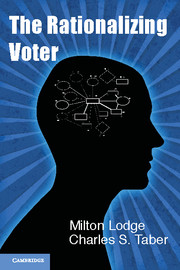Book contents
- Frontmatter
- Contents
- List of Tables
- List of Figures
- Preface
- 1 Unconscious Thinking on Political Judgment, Reasoning, and Behavior
- 2 The John Q. Public Model of Political Information Processing
- 3 Experimental Tests of Automatic Hot Cognition
- 4 Implicit Identifications in Political Information Processing
- 5 Affect Transfer and the Evaluation of Political Candidates
- 6 Affective Contagion and Political Thinking
- 7 Motivated Political Reasoning
- 8 A Computational Model of the Citizen as Motivated Reasoner
- 9 Affect, Cognition, Emotion
- Bibliography
- Index
2 - The John Q. Public Model of Political Information Processing
Published online by Cambridge University Press: 05 March 2013
- Frontmatter
- Contents
- List of Tables
- List of Figures
- Preface
- 1 Unconscious Thinking on Political Judgment, Reasoning, and Behavior
- 2 The John Q. Public Model of Political Information Processing
- 3 Experimental Tests of Automatic Hot Cognition
- 4 Implicit Identifications in Political Information Processing
- 5 Affect Transfer and the Evaluation of Political Candidates
- 6 Affective Contagion and Political Thinking
- 7 Motivated Political Reasoning
- 8 A Computational Model of the Citizen as Motivated Reasoner
- 9 Affect, Cognition, Emotion
- Bibliography
- Index
Summary
In this chapter we set forth our theory of the architecture and mechanisms that determine when, how, and why unconscious thoughts, feelings, and goals come to mind to guide downstream political behavior. We take a constructionist approach whereby the content of one's thoughts, the coloration of feelings, the plausibility of goals, and the force of behavioral dispositions change moment-by-moment in response to “priming” events that spontaneously link changes in the environment to changes in beliefs, attitudes, and behavior. Far from the consciously directed decision-making assumed by conventional models, we see political behavior as the result of innumerable unnoticed forces, with conscious deliberation little more than a rationalization of the outputs of automatic affective and cognitive processing.
The Architecture of Memory
How we picture the world – our mental representation of self, other, and what is out there – is “the residue of a lifetime of observation, thought, and experience,” both conscious and unconscious (Carlston, 2010: 38). A cornerstone of any model of political reasoning then is the citizen's preexisting knowledge and predilections. These long-term factors, functionally speaking, require a long-term memory (LTM) for storing facts, beliefs, images, feelings, habits, and behavioral predispositions, plus a mechanism for “moving” such conceptual objects as leaders, groups, events, and issues from LTM into working memory (WM) where they can be attended to (Barsalou, 1992; Rumelhart and Ortony, 1977; Sanford, 1987; Simon, 1969). Conscious attention is very limited, hence the need for heuristics, habits, and other simplifying mechanisms for thinking, reasoning, and doing (Cialdini, 2001; Lau and Redlawsk, 2006; Lupia, McCubbins, and Popkin, 2000; Kuklinski and Quirk, 2000). The important point is that those concepts and their connections processed in working memory are strengthened and the resulting representation modifies the linkages in LTM.
- Type
- Chapter
- Information
- The Rationalizing Voter , pp. 28 - 73Publisher: Cambridge University PressPrint publication year: 2013



